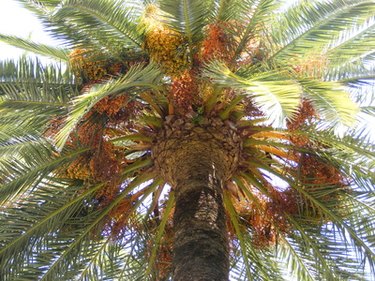
The pygmy date palm is an Asian native from Vietnam and China. It's now adapted to other areas of the world, including some regions of the United States, where winters are mild and usually frost-free. Despite its name, the tree can grow up to 12 feet, topped with a frond of three-foot leaves. But while the pygmy date palm is no doubt a lovely plant, caring for it can be challenging since it's susceptible to several diseases.
Leaf Spot
Video of the Day
Leaf spots are a fungal infection most common in seedlings and young pygmy date palm trees. They begin as small lesions that are saturated with water. The color of the spots can be gray, yellow, red, brown and black. Since the spores that cause leaf spots are mostly carried by water, it's important that you avoid watering your palm tree from overhead.
Video of the Day
Lethal Yellowing
The insect Myndus crudus carries the organism that causes lethal yellowing. As the name suggests, the fronds of date palms infected by the disease become yellow. The long, narrow leaves soon die and dry up before falling off the plant. The entire tree usually dies within six months of the onset of the symptoms.
Petiole Blight
This disease is also known as "rachis blight." With this fungal infection, the leafstalk (petiole) of the lowest leaves develops long, reddish brown streaks. Even though the disease itself only infects the leafstalk, the leaves also end up dying once their life support is gone. As soon as you notice the problem, trim off any stalks that show signs of the disease to keep the spores from infecting healthy parts of the plant.
Bud Rot
The fungus Pestalotiopsis causes bud rot by attacking both the leafstalks and the leaf blades of your pygmy date palm. At first, you'll notice small spots on the leaves and stalks that can be brown, black or yellow. But they will eventually all turn gray with a black line encircling them. Trim off any parts of the plant that look infected and avoid overhead watering to keep the spores from moving to other parts of the plant.
Butt Rot
The fungus that causes date palm butt rot is common in Florida, Georgia and South Carolina. The disease spreads from the inside out as enzymes rot the tree's tissue. By the time you notice the wilted leaves, it may be too late as butt rot is usually fatal.
Red Date Scales
According to the University of Florida Extension Office, the red date scale first arrived in the United States in the late 1800s on infected palms from the Middle East. It has since become a deadly problem to pygmy date palms. If your plant is infected, you'll notice clusters of very small red scales under a white layer of a wax-like substance. The scales usually make their home at the base of new fronds, on any exposed root and on the trunk.
- Florida Plants.com; "Lethal Yellowing of Palm Trees in Florida;" Henry Donselman
- University of Florida IFAS Extension; "Leaf Spots and Leaf Blights of Palm;" Monica L. Elliott
- University of Florida IFAS Extension; "Petiole (Rachis) Blight of Palm;" Monica L. Elliott
- University of Florida IFAS Extension; "Pestalotiopsis (Pestalotia) Diseases of Palm; Monica L. Elliott
- University of Florida IFAS Extension; "Ganoderma Butt Rot of Palms;" Monica L. Elliot and Timothy K. Broschat
- University of Florida IFAS Extension; "Scale Insects Killing Pigmy Date Palms;" Doug Caldwell